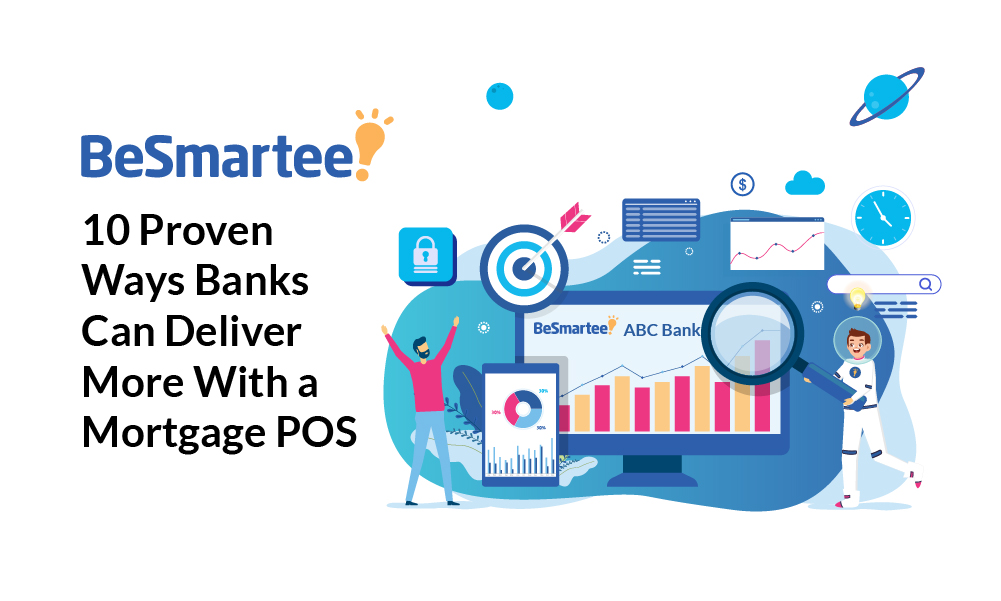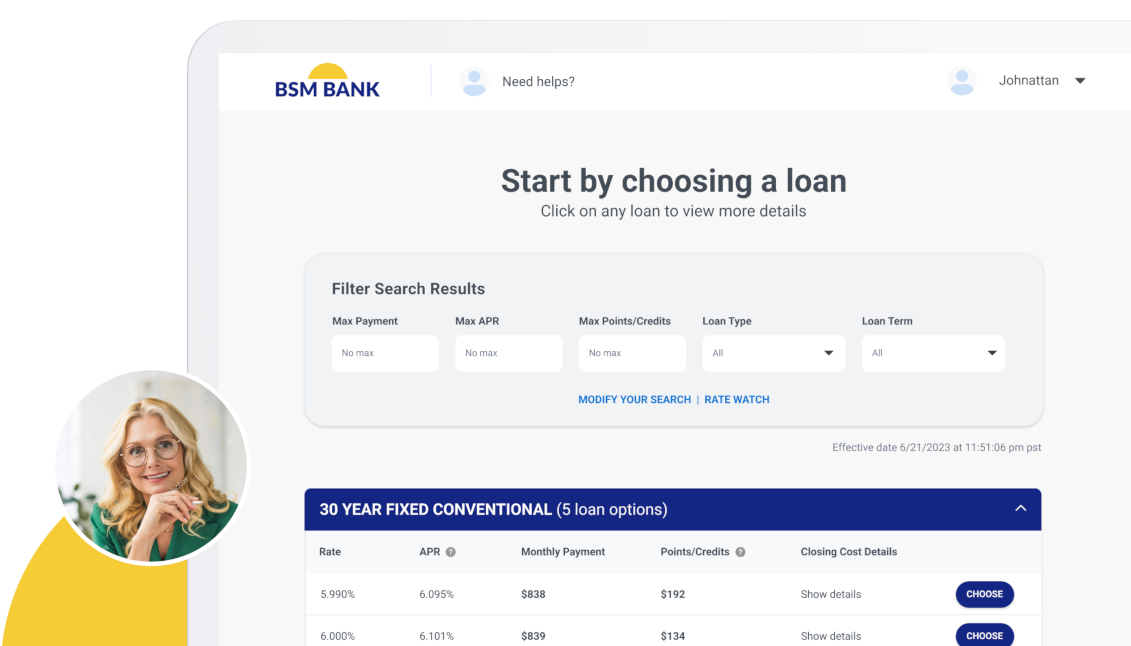Technology is constantly changing the mortgage industry, making it easier for lenders to work with their customers and guide them through the origination process on a digital channel. One of these tools is the mortgage point-of-sale (POS) platform.
The right mortgage POS platform can allow banks to effectively communicate with their customers and provide them with the necessary information and documentation to validate data and complete their mortgage loan application. By accessing a web-based dashboard, borrowers can upload documents, communicate with their lender, and track the progress of their application.
Let’s examine 10 proven ways banks can benefit from the right mortgage POS platform.
1. Improve the Borrower Experience
The digital mortgage is all about the customer experience and it begins at the point-of-sale.
The results from a 2019 survey conducted by McKinsey & Company of 1,200 residential mortgage customers showed that there’s plenty of room for improvement in customer satisfaction. Findings showed that superb customer experience was as important as getting the best rate. First-time home buyers said they relied on online reviews and word of mouth to learn more about how well the bank worked with their borrowers to deliver an exceptional experience.
The year 2020 has further pushed the need to go digital due to the COVID-19 pandemic. Borrowers can continue to receive consistent, outstanding service during the mortgage loan process from the safety of their homes.
The right mortgage POS can give banks the ability to dedicate the time to deliver the best experience possible for their customers.
2. More Control Over Data
Most mortgage POS platforms made their start with a digital 1003 application that could be completed by borrowers at any time and from any device. The digitization of the mortgage process expanded from there into a fully automated lending experience.
In the survey Automating Mortgage Loan Processing conducted by SourceMedia Research, half of the respondents of financial service institutions under $1 billion in assets reported 10 or more incidents a month involving missing borrower documentation.
A streamlined, digital mortgage POS platform means that lenders no longer have to scan stacks of applications and other sensitive financial information from their customers into their system or fax documents to other departments for cross-verification.
Borrowers also have more control over their data on a mortgage POS platform and all necessary parties can see and have access to data needed for finalization in the origination process.
3. Increase Conversion Rates
According to Ellie Mae’s 2019 Borrower Insights Survey, abandonment of an online loan application or requiring multiple sessions to complete the process is not an uncommon occurrence among borrowers.
The customer experience needs to exceed expectations from the moment an application is started and through every stage of the home loan process. Customers want an easy-to-use platform where their application can be completed without any complications.
BeSmartee’s revamp of the borrower loan dashboard and other UI/UX improvements improved the usability and increased conversion rates from 85 to 91%.
4. Shrink Closing Times
The traditional mortgage loan process is extremely tedious. Typical mortgage loan files that exceed 500 pages have an average processing time of around 50 days. A seamless, omnichannel experience and process automation lead to a reduction in loan processing times and ultimately, satisfied customers.
Big lenders are starting to join the fintech surge by integrating fintech solutions, such as third-party mortgage POS platforms, into their digital lending process.
In an interview with HousingWire and Marcus Humphrey, BOK Financial’s senior vice president and director of digital home loan strategy, Humphrey stated that BOK’s time to close has improved as more borrowers transitioned to a digital experience.
5. Access to Big Data
In the mortgage industry, big data can include customer records (bank statements, income records, brokerage accounts) and information from third parties (credit card statements, tax returns, credit history reports). Big data refers to how this information is captured, organized and its searchability. It can be broken down into the four v’s:
1. Volume: the size of the data sets that can be analyzed and processed.
2. Variety: variety in different forms of data.
3. Velocity: the speed at which the data is generated and analyzed.
Subscribe to BeSmartee 's Digital Mortgage Blog to receive:
- Mortgage Industry Insights
- Security & Compliance Updates
- Q&A's Featuring Mortgage & Technology Experts
4. Veracity: the quality of data being analyzed.
Artificial intelligence algorithms examine this data to make decisions and perform updates as new data comes in.
Lenders can use this massive amount of customer data to autofill necessary fields on the loan application.
In an interview with Brian Fluhr, vice president of marketing at First American Database Solutions said, “Lenders have found that information such as ownership, property value, homeowner association information (contact information, lien status and dues amount), tax status information and much more can be retrieved instantly, early in the loan decision process. This greatly reduces the burden on the customer and shortens the time required to make a lending decision.”
Leveraging big data in mortgage POS has resulted in a better experience overall for the borrower and a reduction in cycle times.
6. Reduce Costs
Cutting costs is a top priority for lenders.
Mortgage lenders put a significant amount of time and money into ensuring compliance. Automation systems help lenders guarantee consistent compliance with regulatory requirements by reducing errors or risks in the workflow.
Records management is another big business expenditure. The average office worker uses 10,000 sheets of paper per year and it can cost up to 31 times more to send information via paper products. Accenture’s Your Fast Pass to Digital Mortgage report found that going digital can cut costs by 30%. Going paperless and switching to digital forms will save money on every processed mortgage loan application.
7. Improve Market Share
Borrowers expect a personalized lending experience that fits into their own schedule. They want their lender to be up-to-date on current technology trends and to communicate with them through their preferred channels.
Lenders can increase their market share with a mortgage POS platform by staying on top of trends, prioritizing the needs of their customers, offering more value and expanding marketing strategies.
8. Higher Loan Quality
With 10 errors to every 100 steps in repetitive tasks, rekeying errors is one of the biggest causes of reduced loan quality.
It can also slow down the entire process by creating post-closing audit issues or problems with delivery to third-party investors. Inaccuracies can also increase the chances of risk exposure, inaccurate reporting and major compliance risk.
Moving away from paper documents and repetitive tasks reduces opportunities for human error.
9. Potential for Improved Data Security
Data security is a top concern for mortgage executives. The potential of theft of data from an estimated 60 million U.S. mortgage records with a financial loss of nearly $60 billion let alone the major hit to company reputation and customer confidence is enough to keep anyone up all night.
New technology brings new vulnerabilities but fintech providers used by big lenders generally have substantial security safeguards when their mortgage POS software is up-to-date with every precaution taken by professional software developers.
10. Communication With All Parties Involved from Beginning to End
Using integrated collaboration tools to communicate with all involved parties on a mortgage POS platform means that there’s less of a chance for miscommunication with faster response rates between parties. According to the J.D. Power U.S. Primary Mortgage Origination Satisfaction Study, for each day a customer spends waiting for a response from their lender after an inquiry, customer satisfaction drops dramatically.
Today’s consumers want services on their terms and at their convenience. Being able to communicate during the mortgage loan process through the mortgage POS platform allows lenders to communicate with their customers more often and more effectively.
Roundup
Banks have been slow to jump onto the digital mortgage trend but have worked towards giving their customers a better digital experience.
One way banks, credit unions and non-bank lenders have been able to deliver more is with a mortgage POS. Lenders can now bring their customers from start to finish in a matter of minutes. In banking and mortgage lending, it’s all about the customer experience and surpassing expectations.
Are you interested in learning more about what the BeSmartee Mortgage POS software can do for banks, credit unions and non-bank lenders? Give us a call (888) 276-1579 or email our mortgage technology experts at sales@besmartee.com.




